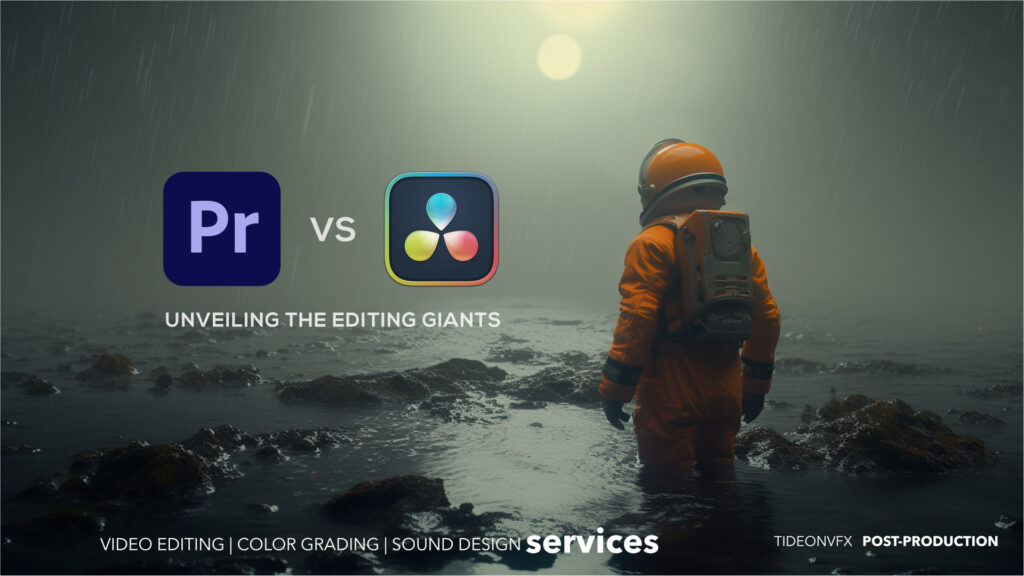Video Editing
Premiere Pro VS Davinci Resolve
Premiere Pro VS Davinci Resolve
Unveiling the Editing Giants: Davinci Resolve vs. Premiere Pro
Introduction:
In the dynamic realm of video editing, two titans stand tall—Davinci Resolve and Adobe Premiere Pro. With the long-standing debate of Premiere Pro VS Davinci Resolve. While the discussion often revolves around pricing models and user preferences, delving into the fundamental differences in workflow can illuminate why Davinci Resolve has become a compelling choice for many. This exploration aims to dissect the intricacies of both platforms, shedding light on their strengths, weaknesses, and the critical question: Should you switch from Premiere Pro to Davinci Resolve? And so the saga of Premiere Pro VS Davinci Resolve continues.
- User Interface: Navigating the Landscape
- Premiere Pro: A familiar timeline-based interface, where users execute various tasks linearly. The dynamic link sends requests to external applications like After Effects and Audition for specialized tasks.
- Davinci Resolve: A unique tab-based design featuring Fusion, Edit, Cut, Color, and Fairlight tabs. Each tab represents a dedicated workspace, seamlessly integrated within the application. Davinci Resolve users can swiftly switch between editing, color grading, audio mastering, and visual effects without the need for external applications.
- Workflow Efficiency: The Power of Tabs
- Premiere Pro: Users accustomed to Adobe’s Creative Cloud suite may find the dynamic link useful, but the transition between applications can introduce workflow interruptions. The linear approach may hinder fluid collaboration between various editing aspects.
- Davinci Resolve: The tab-based workflow empowers users to effortlessly move between tasks. Clicking on the Fusion tab, for instance, instantly transforms the interface into a powerful visual effects workspace. This seamless integration enhances efficiency, allowing users to stay within the same environment for diverse editing needs.
- Pricing Models: The Bottom Line
- Premiere Pro: Adobe’s subscription model requires a recurring fee, which can accumulate over time. While it grants access to an array of Creative Cloud applications, some users may find the ongoing cost prohibitive.
- Davinci Resolve: Davinci Resolve boasts a unique advantage with its free version. While this version is robust and feature-packed, the Davinci Resolve Studio offers additional functionalities for a one-time fee. The Studio version includes advanced features such as 4K and above, motion blur effects, and collaborative tools, making it suitable for professional users.
- Hardware Integration: The Davinci Resolve Ecosystem
- Premiere Pro: Adobe Premiere Pro operates on a wide range of systems, but it doesn’t have a dedicated hardware ecosystem designed specifically for its optimization.
- Davinci Resolve: Blackmagic Design, the company behind Davinci Resolve, offers a line of hardware solutions like the Davinci Resolve Speed Editor and the Davinci Resolve Mini Panel. These hardware options are tailored to enhance the user experience, providing tangible benefits in terms of speed and precision.
- Should You Switch? The Verdict
- If you value a streamlined workflow that seamlessly integrates editing, color grading, VFX, and audio mastering within a single application, Davinci Resolve’s tab-based approach may be a game-changer.
- If you prioritize a familiar interface and have an established workflow with Adobe’s Creative Cloud suite, the dynamic link feature in Premiere Pro could suit your needs.
Integrating AI in the Editing Realm: A Convergence of Innovation
Both Davinci Resolve and Adobe Premiere Pro are at the forefront of integrating Artificial Intelligence (AI) into their workflows. This innovative leap signifies a transformative era where AI-driven features promise to redefine the boundaries of creative expression and efficiency.
Adobe Premiere Pro’s AI-Powered Tools:
Adobe Premiere Pro has been actively incorporating AI-powered tools to enhance user experience and streamline workflows. The introduction of Adobe Sensei, the company’s AI and machine learning framework, has brought forth features like Auto Reframe. This tool intelligently analyzes video content and dynamically adjusts the framing to different aspect ratios, catering to the demands of various platforms. As Adobe continues to invest in AI research and development, we can anticipate further breakthroughs that push the boundaries of automated creativity.
Davinci Resolve’s Fusion Page and Neural Engine:
Davinci Resolve, on the other hand, harnesses the power of its Fusion page and the Neural Engine to bring AI capabilities directly into its editing environment. The Fusion page seamlessly integrates visual effects and motion graphics, and the Neural Engine enhances tasks such as facial recognition, speed warp, and object removal. This marriage of AI and editing tools not only expedites complex tasks but also opens doors to creative possibilities that extend beyond conventional editing boundaries.
The Convergence of Dynamic Features:
As both editing giants invest in AI-driven capabilities, the distinction between them may soon blur even further. AI has the potential to birth dynamic features that are created on the fly, adapting to the unique needs of each project. Automated color grading, intelligent content suggestions, and real-time editing assistance are just a glimpse of the possibilities that AI brings to the editing table.
A Glimpse into the Future:
In this era of AI integration, the competition between Davinci Resolve and Adobe Premiere Pro is not just about the tools they currently offer, but also about their commitment to pushing the boundaries of what AI can achieve in the realm of video editing. The software that successfully leverages AI to empower creatives with dynamic, intuitive, and adaptive features may emerge as the preferred choice, revolutionizing the editing process and setting a new standard for the industry. The future of video editing is undoubtedly a landscape shaped by the collaboration between human creativity and the limitless potential of artificial intelligence.


PASSIVE INCOME MADE EASY
Share monetarily in our expertise as post-production company by becoming an affiliate.
Conclusion:
In the end, the decision to switch from Premiere Pro to Davinci Resolve boils down to individual preferences, workflow requirements, and budget considerations. While Premiere Pro remains a stalwart in the industry, Davinci Resolve’s cohesive design, cost-effective pricing, and dedicated hardware support make it an enticing alternative for those seeking an all-encompassing editing solution. Moreover, the availability of a free version widens the accessibility and democratizes the powerful features of Davinci Resolve for all levels of video editors.
No matter which video editor you choose, it still comes down to the telling of a story, no matter how you twist or turn it. And that in the end is determined by how good the editor themselves are at telling a captivating story through seamless cuts.
I both cases of these applications, you can approach your editing from the creative or technical aspect of editing. You may want to read our blogpost on Creative Vs Technical Video Editor.
If you have any questions concerning this blog post or video editing services, feel free to contact us.




